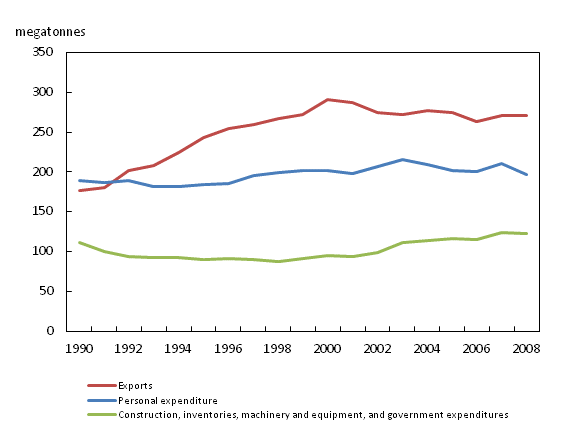Energy use and greenhouse gas emissions, 2008
Archived Content
Information identified as archived is provided for reference, research or recordkeeping purposes. It is not subject to the Government of Canada Web Standards and has not been altered or updated since it was archived. Please "contact us" to request a format other than those available.
Related subjects
-
[an error occurred while processing this directive]
From 2007 to 2008, total energy use in Canada declined 2.1%, while emissions of greenhouse gases (GHGs) fell 2.6%. This occurred as economic growth as measured by gross domestic product increased slightly.
As a result, both energy intensity and the intensity of GHG emissions declined for many industries in 2008. Intensity is measured in terms of energy use per unit of gross output and emissions per unit of gross output.
Half of the top 10 energy consuming industries showed a decline in their energy use required per unit of output. For the top 10 emitting industries, there was a similar pattern of declines in the quantity of GHG emissions required per unit of output.
Households were the largest users of energy in 2008, accounting for 22.9% of national energy use, up from 22.4% in 2007. Total household energy use was stable compared with 2007, as the increase in energy use for home heating and lighting offset a decline in the use of motor fuels.
Primary resource industries were the largest source of GHG emissions, accounting for 27.4% of the total. These industries are more prominent in terms of GHG emissions than in energy use because of fugitive emissions from mining and oil and gas extraction, and the significant contribution of emissions from agricultural soils and livestock.
From a demand perspective, exports and personal expenditure remained the dominant sources of GHG emissions, accounting for 46% and 33% of industrial emissions, respectively.
Greenhouse gas emissions by final demand category, 1990 to 2008

Chart description: Greenhouse gas emissions by final demand category, 1990 to 2008
Note to readers
Environment Canada is responsible for producing Canada's National Inventory Report on Greenhouse Gas Sources and Sinks. This inventory fulfills Canada's reporting obligations under the United Nations Framework Convention on Climate Change (UNFCCC), and is the official benchmark for greenhouse gas emissions in Canada. The year 1990 is the base year of the Kyoto Protocol to the UNFCCC.
Data for 2008 and revised data for 1990 to 2007 from the Material and Energy Flow Accounts are now available. The Material and Energy Flow Accounts describe the annual flows of materials and energy between the Canadian environment and economy. These data are available at the national level only.
Available without charge in CANSIM: tables CANSIM table153-0031 to 153-0034 and CANSIM table153-0046.
Definitions, data sources and methods: survey number survey number5115.
For more information, or to enquire about the concepts, methods or data quality of this release, contact the information officer (613-951-0297; environ@statcan.gc.ca), Environment Accounts and Statistics Division.
- Date modified:
